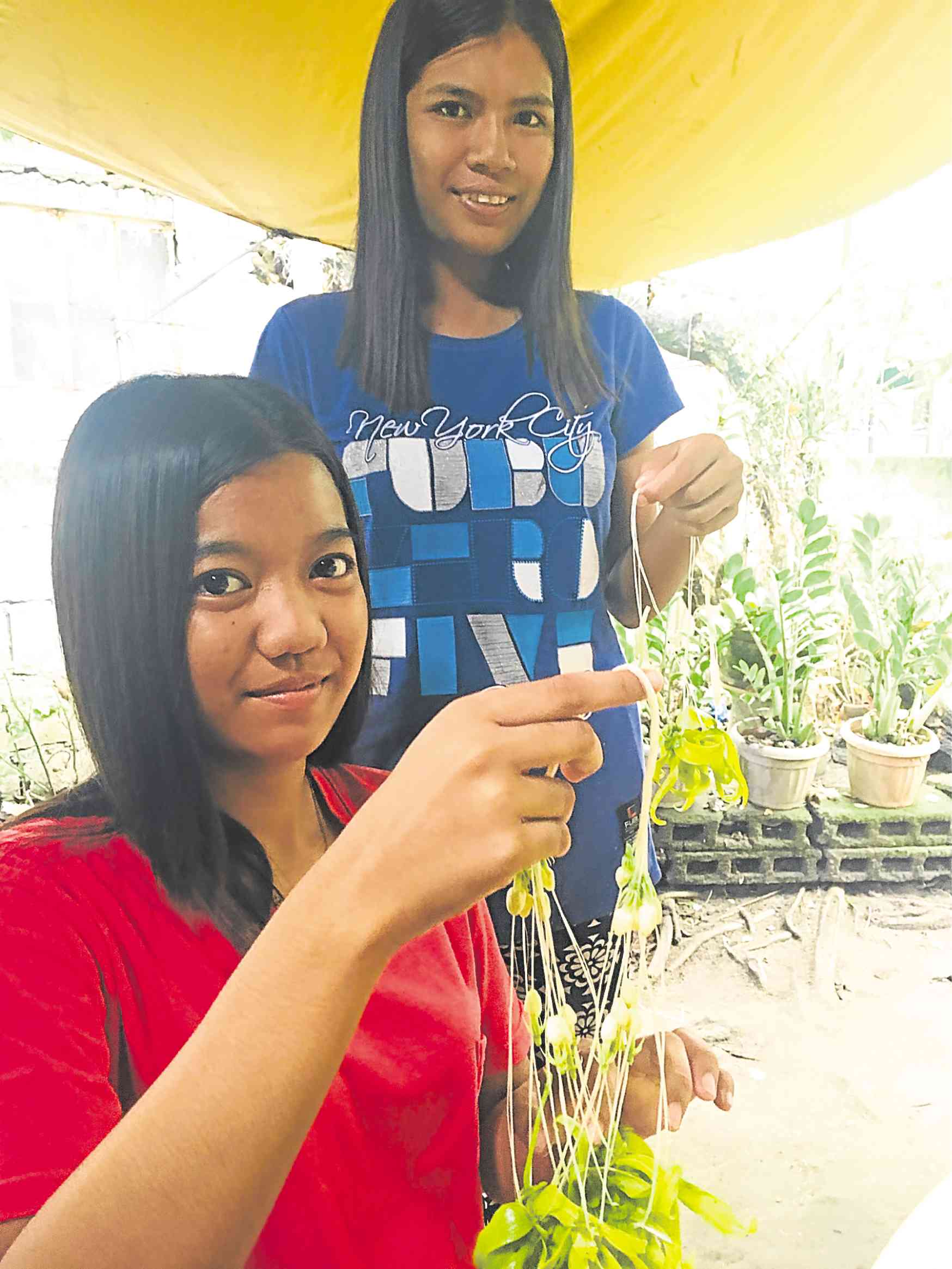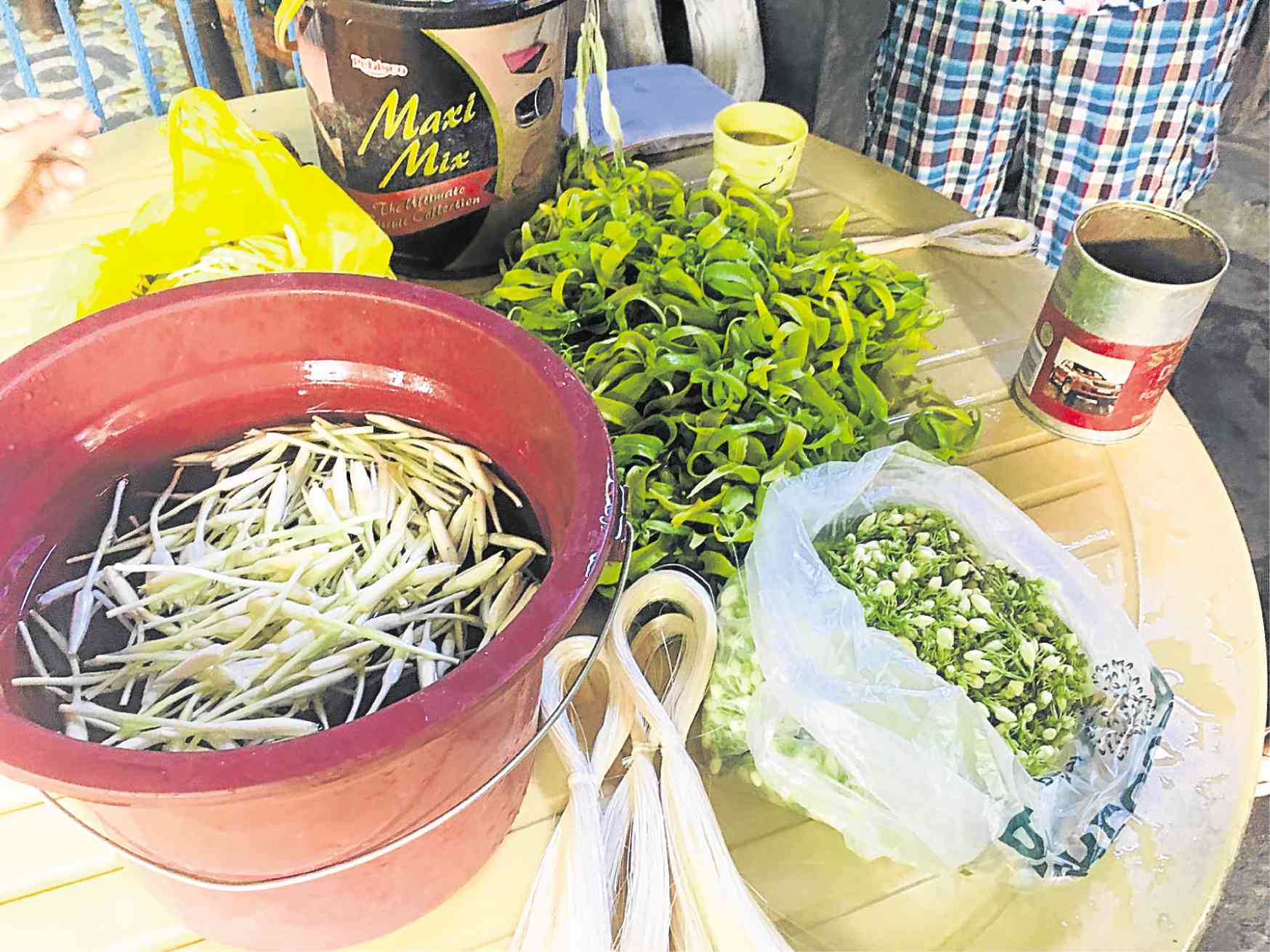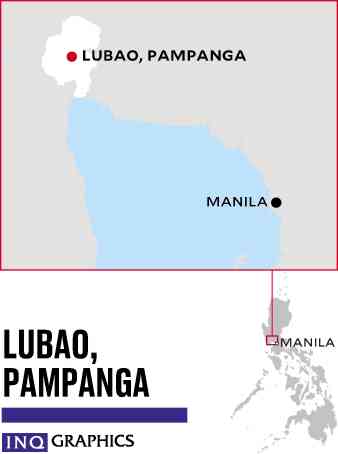Scent of success: Pampanga villagers find lifeline in sampaguita garlands

FLORAL ENTERPRISE Menandro de Mesa (right) and Benedicto Alvarado lead 400 members of Sampaguita Growers Federation in the neighboring Pampanga towns of Lubao, Guagua and Floridablanca. —PHOTOS BY TONETTE OREJAS
LUBAO, Pampanga, Philippines — Around a small round plastic table, women in Barangay San Roque Dau Dos here are busy stringing sampaguita flowers in abaca strands. Their husbands pick “camia” and ilang-ilang flowers, while children as young as 5 years old help in making the garlands.
The community of more than 100 families in Lubao town, Pampanga province, relies on this newly heralded backyard industry to make ends meet.
Delinia Sagad, 71, has been making garlands to tide her family over since she lost her husband at 50.
For a half day’s work of stringing sampaguita flowers, Francesca Bautista, 16, earns P75 to buy school supplies.
Sampaguita growing is the livelihood of 400 other families at Barangays San Roque Dau Uno, Santo Domingo and San Francisco in Lubao; Rizal in neighboring Guagua town; and at Carmencita in Floridablanca town, according to Menandro de Mesa, president of Sampaguita Growers Federation.
Article continues after this advertisementThe plants are grown in 100 to 2,000 square meters of what used to be sugarcane and rice fields.
Article continues after this advertisementBeginnings
The acknowledged pioneer, the late Epifanio Sagad, used to be the laughingstock of his neighbors for planting sampaguita cuttings, says De Mesa, Sagad’s son-in-law.
When Sagad’s enterprise grew, many followed suit. It became De Mesa’s fallback when the Subic Bay Freeport closed in 1992, leaving him jobless.
When she was mayor of Lubao starting in 1991, Gov. Lilia Pineda says planters often requested seedlings and irrigation pumps.
These days, the federation wants to find ways to deal with a Manila-based middleman who dictates prices using a network of local runners, De Mesa says. Prices can go down to P150 a liter.

SCHOOL MONEY Students help their parents create garlands out of sampaguita, “camia” and ilang-ilang flowers and abaca string so they can earn a little for their school needs.
Price pinch
Lubao growers feel the pinch most when prices of the blooms drop in Bulacan and Laguna provinces, where sampaguita is also grown commercially.
For the community in San Roque Dau Dos, the volume of sampaguita available each day decides what kind of garlands will be made.
When it drizzles and there are a few buds to harvest, Lilian Tabunda chooses to make “kalembang” (one ilang-ilang as a centerpiece and two camia buds on each side) and “uno-uno” (two sampaguita buds on each side and one ilang-ilang as centerpiece).
When a liter of sampaguita fetches P300 to P400, Tabunda cannot make a “kumpol” (20 sampaguita buds on each side and 10 for the centerpiece).
“It’s a struggle. I sometimes resort to ‘emergency,’” she says, referring to moneylenders who collect P200 for every P1,000 borrowed.
Tabunda presses the panic button when her buyers in Quiapo, Manila, run away without paying. “But we get by. We are able to eat and send our two kids to school,” she says.
Marketing, financing and modern technology for making value-added products, such as sampaguita perfume and tea, are most needed, according to Benedicto Alvarado, the federation’s vice president.
Sampaguita Festival
The federation is taking in a P2-million loan from the Department of Labor and Employment, but the election ban has delayed its release. Tabunda says it is better to lend the money to members to give them a respite from debts.
In a province that holds many festivals, Lubao stands out as the only town that pays tribute to the national flower through a festival.
Held before the close of the dry season when the fragrant blooms are most abundant, the Sampaguita Festival recognizes hundreds of growers and garland makers, says Mayor Mylyn Cayabyab.
On May 4, even amid the final stretch of the recent election campaign, Lubao’s 44 villages slowed down to form seven clusters to field their best dancers for the street dance competition.
Cluster 4, a group of villages called Matikmus, earned the bragging rights to be the eighth Sampaguita Festival’s grand champion, easing out the almost yearly topnotcher, Cluster Malagu.
The festival was a visual feast because clusters also competed for best in headdress and costume.
Lubao has yet to make sampaguita picking and garland making tourist come-ons. But when the Inquirer visited the town on May 27, the farms, people and materials were ready.
GETTING THERE
To reach Barangay San Roque Dau Dos in Lubao, Pampanga, take a bus going to Bataan, Olongapo City or Zambales and passing through the Gapan-San Fernando-Olongapo (GSO) Road (now Jose Abad Santos Avenue).
Alight at the Guagua-Floridablanca intersection in Barangay Siran. Ride a jeepney and ask the driver to be dropped off at San Roque Elementary School before the San Roque chapel. Take a tricycle to San Roque Dau Dos Purok 6.

